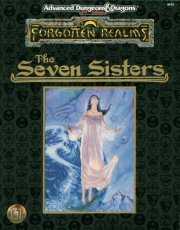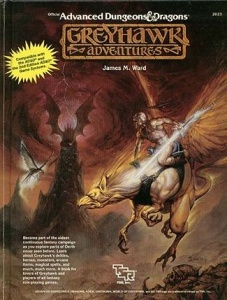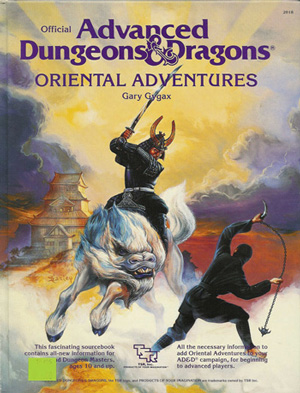I just wanted to do a sample post or two, and show the sorts of things to expect on here. I was thinking the other day about my favorite game supplements and rules books for D&D> I played 1st, 2nd, and the basic game, but never 3rd or 4th. These are my Top Ten favorite supplements.
10. Aurora’s Whole Realms Catalogue
2nd Edition
Forgotten Realms
1992

This clever little book for the Forgotten Realms represents a supposed magazine-ish book distributed by a large wholesaler that offers a variety of different types of goods. Each good comes with a picture, description of why you should buy it, and a price tag. It includes a ton of awesome stuff for your campaigns, and it is one of the best readings I have gotten from a AD&D supplement. Great stuff!
9. Van Richten’s Guide to the Ancient Dead
2nd Edition
Ravenloft
1994

This supplement took a minor enemy from the basic enemies (the Mummy) and turned it upside down, and created one of the most intricate enemies you can have. A lot of the book is fluff, but what it does have is a lot of meat for creating interesting, unique, and powerful undead creatures. It creates scales of power, interesting abilities, and more.
8. Wizards Spell Compendium, Vol 1-4
2nd Edition
1997

I know this set did the same thing as the Priest’s Spell Compendium and Encyclopedia Magica for their media, and that all it does is simply, in four volumes, list every spell ever printed. However, this is the best by far. For example, it’s hard to add Priest spells to your campaign. How does a deity just suddenly start increasing randomly the spells they grant to priests? It’s hard to justify it in campaign more than once or twice. The magic items rock, and the more the merrier, and I use the Encyclopedia Magica a ton. However, making a magic item is a ton of work. Wizards have to research the formula, chase down the exotic ingredients, find the spells, and then spend a ton of time making the actual item, and some spells deplete the caster’s body and/or soul in order to imbue the item with permanent magic. Therefore, they are not easy to make. However, you can make a new spell in 2-3 months, done. That one item can be broken or lost easily. You put your name on your spell, start selling scrolls of it or trading it, and within a couple of years, Abe’s Mighty Aleatory is suddenly known by a bunch of other magi. It has a much better chance of staying after you die, will get your name better known, gives you unique spells to trade for other rare spells, doesn’t take too long, and such. Thus, your campaign world should have a few known priest spells, a lot of magic items, and a literal plethora of wizard spells coming out of people’s ears. The only issue I have is that the spells were not usually put into the new schools so I have to go through, read them all, and add them to the new schools – like artifice. That, plus it’s just a reprint of every spell ever, drops it back from a higher berth.
7. The Seven Sisters
2nd Edition
Forgotten Realms
1995

This book took an in story idea of those few powered by a goddess to powerful levels, and gave you tons of info on them. You saw tons of stats and background on each of the characters so imbued, and then game information on how to do it, and what advantages come with it, and then finally, tons of very powerful spells made by this core of powerful characters. The supplement is detailed, gives you rules for cool characters that have never existed before of any sort, and is a nice treat.
6. Campaign Sourcebook and Catacomb Guide
2nd Edition
1990

The artless cover for some of these books is going to suck, I admit. This books is divided into two parts. The first gives you, the Dm, tons of tip[s on how to run a game. Instead of lots of rules, instead it gives the DM guidelines and info on how to run the best campaigns, create the best worlds, and so forth. Then it actually has runs and tricks on how to create your own world, followed by information about creating maps and stuff. In some ways, it is a better DM’s Guide than the actual DM’s Guide. It’s amazing, and has info from everything from ordering snacks and cleaning up after a gaming session to world build tips. Amazing.
5. Greyhawk Adventures
1st Edition
Greyhawk
1988

This is a classic book for your library. It is a textbook example of having a tome that is thick with good stuff for games. It includes tons of stuff from new rules on how to run 0 level adventures to a ton of spells, magic items, new creatures, detailed rules on deities and their clerics that gives you just enough info, rules and info on major players, several mini-adventures you can use and my favorite – many geographical anomalies and why they were formed, and what sorts of creatures and interesting things are there, to give you many ideas for adventures of your own creation. Just a very solid book from start to finish.
4. The Complete Book of Necromancers
2nd Edition
1995

This book was jam packed with stuff, and looked at a great way to make NPC and enemy necromancers something truly villainous. The new kits were great, the new items interesting, the new non-weapon proficiencies essential (like venom handling), and everything from dark gifts, weaknesses, salient powers, to a map and dungeon at the end was great. It took a corner of the universe and fleshed the crap out of it in a beautiful way.
Top three, here we go...
3. The Complete Fighter's Handbook
2nd Edition
1989

Right after they released the 2nd Edition rules that just codified the 1st Edition rules in one place and streamlined some stuff, they added major ideas to the game. This book became essential. Not only did it add things like new weapons to the mix, but it also created a lot of new ideas for ways that characters can fight. Specialization in fighting styles was brand new, as well and broad and narrow group proficiencies. However, what the CFH will be forever known as was the introduction of Kits to AD&D, and it was one of the best additions to the game from 2nd Edition.
Top Two:
2. Player's Option: Skills and Powers
2nd Edition
1996

This book was part of the Player’s Option revolution that included Combat and Tactics, and Spells and Magic. This introduced the idea that when you create a character, you can choose your race bonuses and class abilities and later weapon and non-weapon proficiencies all by using character points. It was a genius idea to tack onto D&D. It was, in my opinion, the best version of D&D ever. Because 3rd edition moved away from that, I stick with 2nd Edition Player’s Option as my preferred option.
And finally....
Oriental Adventures
1st Edition
Kara Tur
1985

What can you say about this product that has not been said already? I guess you could say it sucked – no one has ever said that. Replacing the normal classes and races with all new ones, and yet retaining the basic rules for AD&D, this book became arguably the single iconic book of AD&D 1th Edition and was one of the best selling ones of all time, period. From the new spells, new elemental system, new everything – including a new world, Kara-Tur detailed very well – you have one of the best supplements of all times, an d the best one for 1st Edition. It still has stuff in it that was never redone for later editions, and thus stands up very well. Oh, and did I mention it introduced non-weapon proficiencies?
No comments:
Post a Comment